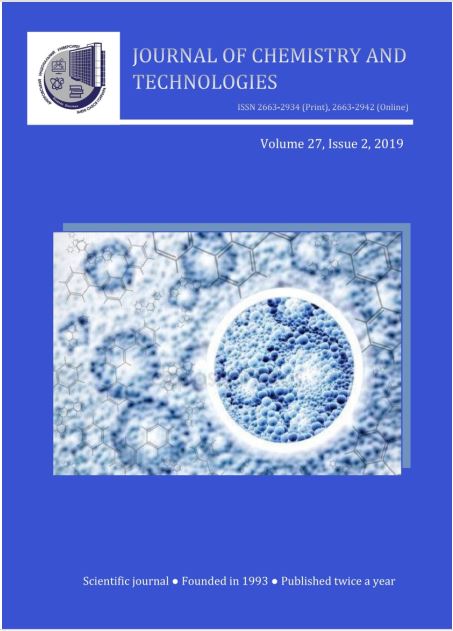MODELING OF THE VISCOPLASTIC FLOW OF A BINGAM FLUID WITH TRANSVERSE CIRCULATION IN A RECTANGULAR CHANNEL OF A WORM MACHINE
DOI:
https://doi.org/10.15421/081921Keywords:
Bingham fluid, flow, circulation, model, channel, worm machine.Abstract
Introduction. We proposed a mathematical description of the flow of a Bingham fluid with transverse circulation in a rectangular channel of a worm machine. Materials and methods. As a material, we chose Bingham fluids with two constant parameters - viscosity and fluidity thresholds. We overviewed the influence of the transverse circulation on such characteristics of the visco-plastic flow as the size of the solid core, velocity of the core and flow rate. The flow in a rectangular channel is formed as a result of superposition of flows in two plane channels which are crossed at right angles. Results. During the simulation of the three-dimensional flow of Bingham fluid in the channel of a rectangular cross-section with transverse circulation, two basic elements are applied. The first one consists of dividing the rectangle into a solid core and four rectangular sections of the viscous flow. The second element is that the viscous flow in each of the plots is two-dimensional, that is, longitudinal and transverse, but depends on one coordinate. This means that such flows are equivalent to flows with transverse circulation in a flat channel, the core of the flow of the Bingham fluid has a rectangle at the intersection. This approach allows to calculate all the basic characteristics of a complex three-dimensional flow in the explicit analytical form and analyze its dependence on the boundary conditions, taking into account the influence of all eight longitudinal and transverse conditions, with any possible distribution on the boundaries of the channel. We proposed the calculation formulas for determining the velocity of the core of the current, flow rates, and the values of dissipation energy in a symmetric form with respect to the coordinates. Conclusion. The mathematical description of the longitudinal flow of a Bingham fluid with transverse circulation in a rectangular channel of a worm machine allows for the simulation of various flows of visco-plastic liquids and to determine the macro-kinetic characteristics at each point of the channel.References
Anandha, Rao M. (2014). Rheology of Fluid, Semisolid, and Solid Foods: Principles and Applications. New York, USA : Imprint: Springer.
Gale, M. (2009). Mixing in Single Screw Extrusion. USA: Smithers Rapra Press.
Ostrikov, A.N., Abramov, O.V., Rudometkin A.S. (2004). [Extrusion in food technology]. Saint Petersburg. Russian Federation: Giord. (in Russian).
Yasnogorodsky, A. L. Zvezdin, A.G. (2006). [Multi-purpose twin-screw machines for processing technologies]. Kharkov. Ukraine: Prapor. (in Russian).
Rauvendal, K. (2006). [Extrusion of Polymers] Saint Petersburg. Russian Federation: Profession. (in Russian).
Kolgruber, K. (2016). [Twin-screw, co-directed extruders. Basics, technology, application] Saint Petersburg. Russian Federation: Profession. (in Russian).
The official website company Komax. (2015). [Single screw extruder range Helibar U]. http:// www.komax.pro/en/extrusion/extruder-long-helical-grooves
Bonten, K., Oliver Cast (2016). [Resource efficiency in plastics technology] Institut für Kunststofftechnik Stuttgart, Germany, According to the materials of the Motiva Group, Helsinki.
http: // www. motiva.fi/Files / 9729 / 02_Resource_efficiency_in_plastics_industry_Bonten_Kast.pdf
Tovazhnyansky, L. L., Biletsky, E.V., Tolchinsky Yu. A. (2013) [Modeling of flows of non-Newtonian fluids in channels of basic geometry]. Kharkiv. Ukraine: NTU "KhPI". (in Ukraine).
Kirsanov, E. A., Matveenko V. N. (2016). [Non-Newtonian Current of Disperse, Polymer, and Liquid Crystal Systems] Moscow. Russian Federation: Technosphere. (in Russian).
Ulyev, L. M. (2016). [Laminar flow in coaxial conical channels]. Kharkiv. Ukraine: NTU "KhPI". (in Ukraine).
Ponomareva, M. A. Filina, M. P., Yakutonok, V. A. (2016). [Circulating flow of high viscosity non-Newtonian fluid in a single-screw extruder channel]. Vestnik Tomskogo gosudarstvennogo universiteta. Matematika i mekhanika, 2 (40), 97–107.
Perminov, A. V., . Lyubimova, T. P. (2014). [Stability of a stationary plane-parallel flow of a pseudoplastic fluid in a flat vertical layer]. Vychislitel'naya mekhanika sploshnykh sred. 7(3). 270 – 278. (in Russian).
Cantelli, A. (2009). Uniform Flow of Modified Bingham Fluids in Narrow Cross Sections Journal of Hydraulic Engineering. 135(8). 640-50.
Golovanchikov, A. B., Shagarova, A. A. (2015). [Modeling the flow of a viscoplastic reaction mass in a screw reactor with a low viscosity wall layer]. Izvestiya vuzov. Khimiya i khimicheskaya tekhnologiya. 58(12), 69–72. (in Russian).
Biletsky, E. Petrenko, E., Semeniuk, D. (2014). Theoretical aspects of non-newtonian fluids flow simulation in food technologies. Ukrainian Food Journal. 3(2), 271–280.
Biletsky, E. Petrenko, E., Semeniuk, D. (2016). Three-dimensional model of non-Newtonian fluid flow in the rectangular channel. Ukrainian Food Journal. 5(3), 550-560.
Mitsoulis, E., Tsamopoulos, J. (2017). Numerical simulations of complex yield-stress fluid flows. Rheologica Acta 56. 231–258.
Saramito, P., Wachs A. (2017). Progress in numerical simulation of yield stress fluid flows. Rheologica Acta 56. 211–230.
Frigaard, I. A., Paso, K., de Souza Mendes, P., (2017) Binghams model in the oil and gas industry. Rheologica Acta 56. 259–282.
Downloads
Published
Issue
Section
License
Copyright (c) 2020 Днипровский национальный университет имени Олеся Гончара

This work is licensed under a Creative Commons Attribution 4.0 International License.
- Authors reserve the right of attribution for the submitted manuscript, while transferring to the Journal the right to publish the article under the Creative Commons Attribution License. This license allows free distribution of the published work under the condition of proper attribution of the original authors and the initial publication source (i.e. the Journal)
- Authors have the right to enter into separate agreements for additional non-exclusive distribution of the work in the form it was published in the Journal (such as publishing the article on the institutional website or as a part of a monograph), provided the original publication in this Journal is properly referenced
- The Journal allows and encourages online publication of the manuscripts (such as on personal web pages), even when such a manuscript is still under editorial consideration, since it allows for a productive scientific discussion and better citation dynamics (see The Effect of Open Access).


